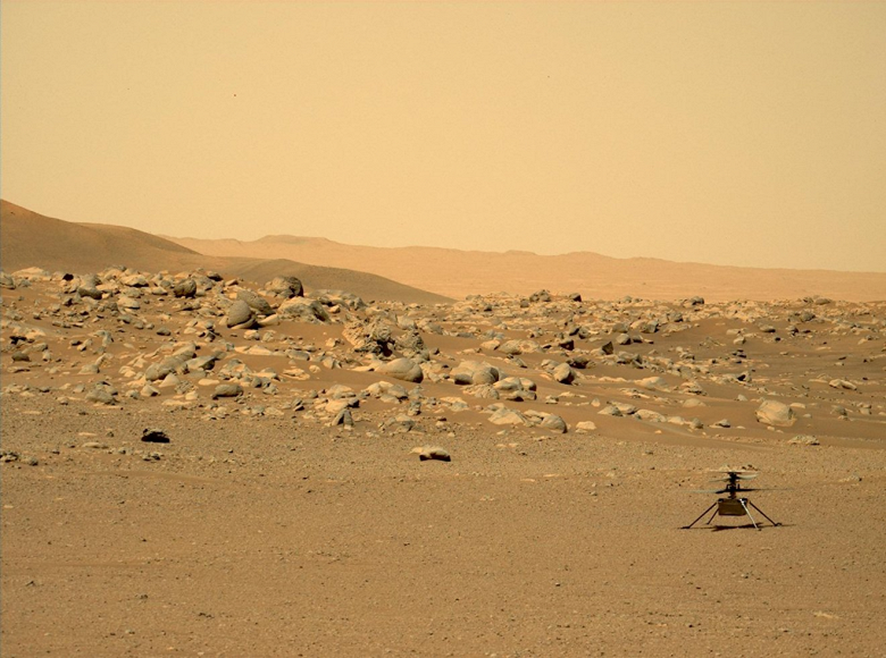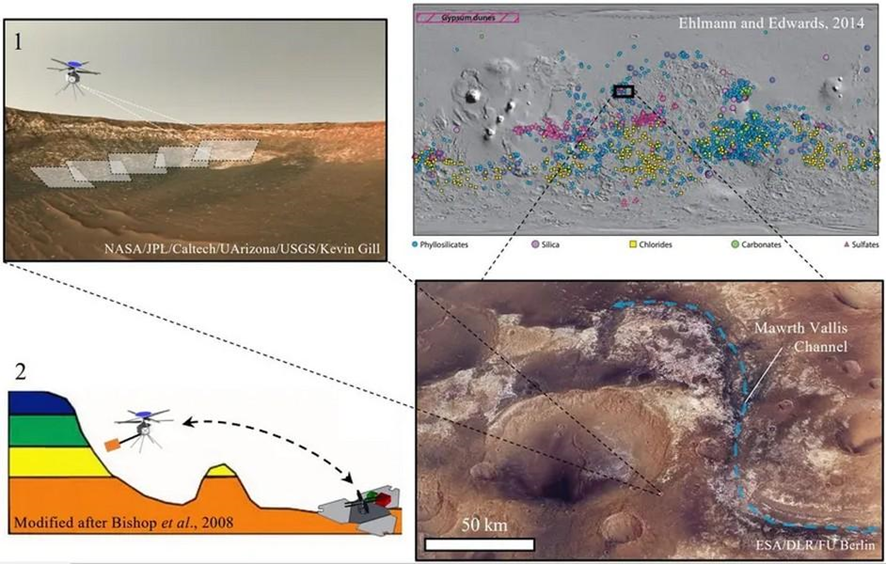how Ingenuity is changing the approach to the study of planets and satellites of the solar system
About the unmanned robotic helicopter Ingenuity, which has already made more than fifty flights on Mars, they began to write much less often than before. It is understandable – after all, his work gradually began to be perceived as an ordinary routine. But this device should not be forgotten, because it is likely to be the first of many Earth-controlled aircraft that are exploring other worlds. Its value is equated by many experts with the value of the Wright brothers’ aircraft (a tiny piece of fabric covering the aircraft, by the way, is in the marsoleet). At the same time, Ingenuity is much more successful than that plane. We’ll talk about all this today.
Why the marsoleet appeared only recently
Automatic devices from the Earth began to study the planets and satellites of the solar system for a long time. But these were either static systems that descended to the surface and then transmitted data, or systems on wheels. Now we are talking about the direct study of the surface of other objects, so we do not mention orbital stations and systems that flew past planets and satellites on a tangent.
Ingenuity became the first remotely controlled aircraft on another planet in the history of astronautics. Why only now? The fact is that earlier there were no technologies necessary for the development of such a device. For example, batteries of the type that are used to power a marshall appeared only in the 90s of the XX century, not to mention carbon fiber. Similarly, it was not previously possible to create miniature devices and software for flight control of these devices.

In addition to all this, the Marshall had to be strong enough to withstand takeoff from Earth, flight in space with its extreme conditions, landing on Mars and unpacking. This is an extremely difficult task that has been successfully completed.
Another difficulty is that the density of the Martian atmosphere is less than 1% of the density of the Earth’s atmosphere. In order to make a flight, a vehicle designed for Mars must be very light, but still carry a battery, photocells, sensors, a camera or cameras, plus a heating and thermal insulation system.
According to Teddy Zanetosa of the Jet Propulsion Laboratory in Pasadena, who led the Ingenuity team, the technological innovations had to “come together at the right moment.” At the same time, before the concept of a helicopter appeared, scientists and engineers considered the possibility of creating an aircraft. But this idea was abandoned, since such an aircraft needed a runway.
Ingenuity Achievements

His main achievement is that he took off, taking pictures of the surface of Mars. The Marshall mission would have been considered a success if the device could only complete one flight, despite the fact that five flights were originally planned. Well, Ingenuity turned out to be so well designed that it withstood fifty flights, the Martian winter, the failure of one of the modules and the dusting of horizontal surfaces, including solar panels.
As for the achievements, then, in principle, they can be considered each new flight of the system. So, for the first time, a marsolet took off at a speed of about 1 m / s by 3 meters, and, after hanging for the prescribed 30 seconds, landed 39.1 seconds after takeoff.
The second flight was even more successful, as Ingenuity climbed to 5 meters, after which:
● performed three consecutive turns of approximately 1/4 of a circle each (276° in total);
● at a speed of 0.5 m/s moved 2 meters sideways with a return back (the total path was 4.3 meters);
● took the first three high-altitude photographs with the RTE camera;
● after 51.9 seconds, landed at the starting point, thus making a return flight.
Then the marsolet performed flights with various purposes: conducting maneuvers, testing cameras, etc. The ninth flight was a record one in terms of length – the device flew 625 meters at once, successfully descending to the surface of the planet.
Cruise 12 showed the real benefit of color aerial photography for the operation of the rover – one of the photographs taken by Ingenuity showed the need to correct the way the rover avoided obstacles in the Artubi Ridge.
In September 2021, the helicopter mission continued, although some experts argued that it could be considered completed, and Ingenuity should remain on the surface of Mars in order to free its crew for other tasks.
The 25th flight was a record both in speed – 5.5 m / s, and in length – 704 m.
On its 26th flight, the marsolet photographed the parachute and fragments of the “shell” of the expedition’s lander.
Problems followed, including a power shortage with the onboard computer timer heating turning off. Because of this, communication with the device was lost for a couple of days. Then it was restored, but it turned out that the inclinometer was out of order (precisely due to the heating being turned off), after which its functions were assigned to other inertial navigation sensors.
Subsequent flights were more or less similar, but in any case they gave a lot to science. During the 49th flight, the marsolet reached a speed of 23.3 km / h and rose to a maximum height of 18 meters. At the moment, this is a record for this device.
The jubilee, 50th, flight was made on April 13, 2023. It marked the success of the team of engineers who worked to create the device. Ingenuity exceeded its expected service life by as much as 23 Earth months and 45 flights.
In the course of 50 flights, Ingenuity spent a total of more than 89 minutes above the surface of Mars, covering 11.6 km.
What’s next?
Now NASA and other organizations are developing new projects of aircraft for Mars and other planets and their satellites. For example, a group of Chinese scientists led by Bian Chunjiang from the National Space Science Center (NSSC) in Beijing is developing a helicopter for flights to Mars.

The design of the new marsoleet is similar to the design of the forerunner – all the same two sets of blades on one rotor mast to provide lift during vertical takeoff and landing in a rarefied Martian atmosphere. But it is somewhat larger, in addition, according to the plan of Chinese engineers, the device will be able to fly at a height of 5-10 meters, reaching a speed of about 300 meters per minute, with a possible flight duration of 3 minutes.
Most likely, the Chinese aircraft will accompany the Chinese rover, which will be sent to the Red Planet in 2028.
As for NASA, the US agency is developing a system that will be as much as 6 times larger than its predecessor. The mass of the new device will be 30 kg. It will operate without being tied to the rover, using its own robotic arm and microdrill to deliver samples back to the lander.

Aircraft concept for TitanThe hexacopter will search for underground water ice over a wide area, as well as collect atmospheric data from the lower atmosphere, which are difficult to measure from the surface or orbit. In addition, the system will be able to take soil samples in flight, for example, from the walls of craters.
And this is only Mars, scientific organizations from different countries plan to send aircraft to other planets and satellites of the solar system. For example, Venus and Titan. According to Melissa Trainer, deputy head of the Dragonfly mission research team, Titan is an ideal place for heavier-than-air craft. Simply due to the fact that there is low gravity and a dense atmosphere.

True, due to the cloud cover on Titan, there is not much solar energy. But this is fixable – due to the size (much larger than a marsoleet), the Dragonfly will be able to carry a powerful nuclear battery developed by NASA.
As for Venus, this planet is both suitable and unsuitable for flights. Suitable because the atmosphere there is much denser than the earth, about 90 times, so the apparatus can be really large. And the problem is that the surface temperature of Venus is +475 degrees Celsius, and the pressure is 93 bar, which roughly corresponds to a one and a half kilometer depth of the ocean.
Perhaps scientists will launch something like a solar-powered aircraft to Venus that will fly above the clouds for an extended period of time, rather than a copter. There, the temperature is not so high, and the atmosphere is much less aggressive. It is also planned to use a Stirling engine that converts external heat into electricity.
Tiny Ingenuity gave a huge start to the future. By his own example, he proved the operability of the concept of an aircraft with propellers for studying other planets, so that further scientists and engineers can create various versions of such systems. Perhaps in a few years, devices from the Earth will flutter over the surface of Mars, Venus and Titan, and maybe other objects in the solar system.



